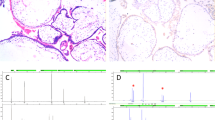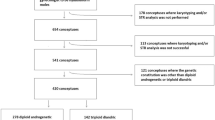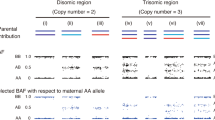Abstract
Complete hydatidiform mole is an abnormal human pregnancy with grossly swollen chorionic villi, usually with a 46,XX karyotype, and with a propensity to malignancy1. The XX moles originate from fertilization of an ‘empty egg’ (resulting from either enucleation or inactivation of the female pronucleus) by a haploid sperm and its subsequent duplication2,3, a process called diploid androgenesis. XY moles, although infrequent, are of special interest because their origin must differ from that of the XX moles. Two XY moles have been studied for their origin, but the results were inconclusive3,4. We describe here a study of four XY moles, and provide evidence that they result from the fertilization of an empty egg by two haploid spermatozoa.
This is a preview of subscription content, access via your institution
Access options
Subscribe to this journal
Receive 51 print issues and online access
$199.00 per year
only $3.90 per issue
Buy this article
- Purchase on Springer Link
- Instant access to full article PDF
Prices may be subject to local taxes which are calculated during checkout
Similar content being viewed by others
References
Vassilakos, P., Riotton, G. & Kajii, T. Am. J. Obstet. Gynec. 127, 167–170 (1977).
Kajii, T. & Ohama, K. Nature 268, 633–634 (1977).
Jacobs, P. A., Wilson, C. M., Sprenckle, J. A., Rosenshein, N. B. & Migeon, B. R. Nature 286, 714–716 (1980).
Surti, U., Szulman, A. E. & O'Brien, S. Hum. Genet. 51, 153–156 (1979).
Ray, J. G., Hare, D. B., Peterson, P. D. & Kaybee, D. E. (eds) Manual of Tissue Typing Techniques, 20–22 (NIH, Bethesda, 1974).
Spencer, N., Hopkinson, D. A. & Harris, H. Nature 204, 742–743 (1964).
Hopkinson, D. A., Mestriner, M. A. & Cortner, J. Ann. hum. Genet. 37, 119–137 (1973).
Wake, N., Takagi, N. & Sasaki, M. J. natn. Cancer Inst. 60, 51–57 (1978).
Wake, N., Shiina, Y. & Ichinoe, K. Proc. Jap. Acad. 54, 533–537 (1978).
Lawler, S. D. et al., Lancet ii, 580 (1979).
Kajii, T. Gann Monogr. Cancer Res. 25, 189 (1980).
Author information
Authors and Affiliations
Rights and permissions
About this article
Cite this article
Ohama, K., Kajii, T., Okamoto, E. et al. Dispermic origin of XY hydatidiform moles. Nature 292, 551–552 (1981). https://doi.org/10.1038/292551a0
Received:
Accepted:
Issue Date:
DOI: https://doi.org/10.1038/292551a0
This article is cited by
-
Genome-wide single nucleotide polymorphism array analysis unveils the origin of heterozygous androgenetic complete moles
Scientific Reports (2019)
-
Characteristics of hydatidiform moles: analysis of a prospective series with p57 immunohistochemistry and molecular genotyping
Modern Pathology (2014)
-
Histopathological Diagnosis of Partial and Complete Hydatidiform Mole in the First Trimester of Pregnancy
Pediatric and Developmental Pathology (2003)
Comments
By submitting a comment you agree to abide by our Terms and Community Guidelines. If you find something abusive or that does not comply with our terms or guidelines please flag it as inappropriate.



